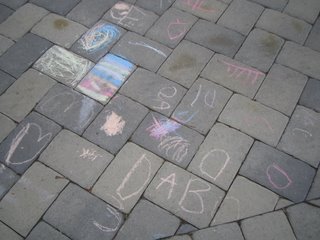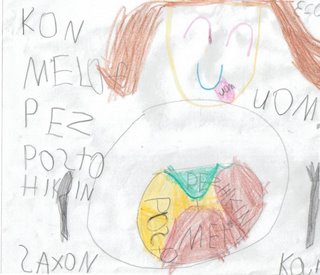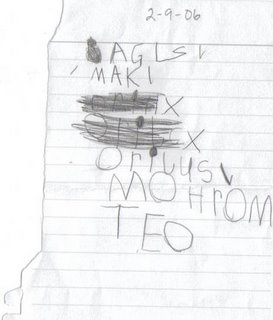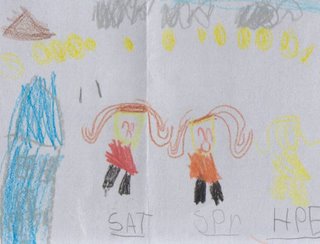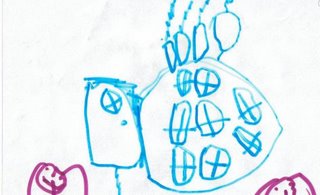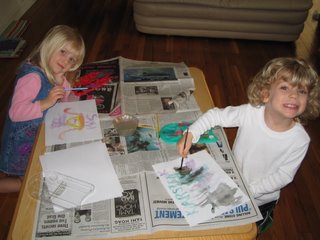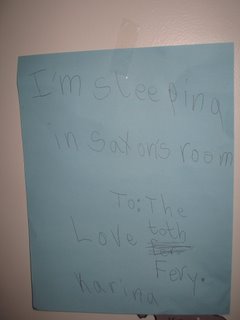I've been hearing about Bringing the Boy Home for a couple of months now from my 3rd grade daughter who kept talking about this wonderful book her teacher was reading aloud to the class. After finishing it, she convinced her older sister to read it as well. Older sister whizzed through it, seemingly without putting it down, and then they started in on me. "You HAVE to read it mom! It is SO good!"
Once I picked it up, I couldn't put it down either! It is the story of two boys who are part of an Amazon tribe, deep within the jungle. In order to prove themselves as men, they must pass a test of endurance, bravery and skill. The twist is that one boy was abandoned by his parents at age 6 and spent the last 7 years in Florida with his adopted mother. Can a boy who is part of modern American culture prove himself in the Amazon?
The story plays with the themes of family, loyalty, bravery, trust. Had I read the book first I would have said that the book is for boys, but it resonated with my girls as well. It has adventure, excitement, emotion and drama, and best of all, it takes the reader outside of any world or culture they have ever known while showing that many themes are not owned by any one culture. I would highly recommend this book for any reader ages 8 to 12.
Thursday, June 24, 2010
Wednesday, June 23, 2010
Free Play
A toddler wades into a man-made pond at the park, then plops herself down in the water. Mom laughs and stands at the edge of the pond, supervising from a close distance. Nearby another mother watches as her five year old makes sandballs, dipping her hands into a pail of water, grabbing a handful of black, wet sand to roll and shape into her desired shape, size and consistency.
The dripping child from the pond loses interest in the water and wanders off toward the sandbox where she too wants to make sandballs. Naturally all the children are covered in sand, and it's not nice and clean sand. It is black and constantly left out in the elements. It's not unlikely to find a cigarette butt or other garbage in the sandbox, and who knows how many cats use it at their litter box.
Is it irresponsible parenting or a wonderful opportunity for the children?
I admit that I have a hard time allowing my kids to become so deliciously dirty as they learn, play and discover. In sand and water they come to know the properties of both. They pour, lift and measure and they make plans to follow through and they develop large and fine motor skills. They learn that when they play in water they get wet, and when they play in sand they become dirty which is cause and effect. They learn that they might feel uncomfortable, or some might enjoy the sensations.
But perhaps best of all, they are learning that they are free to explore and investigate and try new things.
Did it make life more difficult for Mom? Absolutely! There is extra laundry to deal with as well as the added logistical hassle of the trip home from the park. It's not always easy to clean all that sand out of the hidden folds of skin young children have.
What about the dirt, germs, garbage and bacteria? If the children are generally unhealthy with weak immune systems, that could be a problem. With otherwise healthy children, as long as they are not eating the sand or drinking the water, they build up a healthy immune system by playing outside and becoming dirty.
The key is to remember:
Children are washable.
The dripping child from the pond loses interest in the water and wanders off toward the sandbox where she too wants to make sandballs. Naturally all the children are covered in sand, and it's not nice and clean sand. It is black and constantly left out in the elements. It's not unlikely to find a cigarette butt or other garbage in the sandbox, and who knows how many cats use it at their litter box.
Is it irresponsible parenting or a wonderful opportunity for the children?
I admit that I have a hard time allowing my kids to become so deliciously dirty as they learn, play and discover. In sand and water they come to know the properties of both. They pour, lift and measure and they make plans to follow through and they develop large and fine motor skills. They learn that when they play in water they get wet, and when they play in sand they become dirty which is cause and effect. They learn that they might feel uncomfortable, or some might enjoy the sensations.
But perhaps best of all, they are learning that they are free to explore and investigate and try new things.
Did it make life more difficult for Mom? Absolutely! There is extra laundry to deal with as well as the added logistical hassle of the trip home from the park. It's not always easy to clean all that sand out of the hidden folds of skin young children have.
What about the dirt, germs, garbage and bacteria? If the children are generally unhealthy with weak immune systems, that could be a problem. With otherwise healthy children, as long as they are not eating the sand or drinking the water, they build up a healthy immune system by playing outside and becoming dirty.
The key is to remember:
Children are washable.
Tuesday, June 22, 2010
Reading Aloud
"Can you read this to me please?" a child will ask, and who can say no? Well, perhaps we buy some time with a "Later, OK?" but ultimately, anyone who spends time around children and books will have opportunities to read aloud.
Some of us feel more confident in our abilities to read to an audience than others. We might have an idea in our heads of what the book should sound like, but we are afraid of over-acting or sounding silly. It could be that simply getting the words past our lips is work enough in itself and we don't have any energy left to try to make it sound like something.
Reading aloud to children is a skill that can be learned and improved upon with practice. We don't all have to become professional story tellers or performers, but most of us could use some extra help!
Do:
1. Enjoy the story.
2. Think about what you're reading.
3. SLOW down; it is not a race!
4. Lower your pitch to avoid a squeaky, high voice.
5. Make your voice softer for effects instead of louder.
6. Build in pauses for dramatic effect.
7. Take time to enjoy the illustrations.
Don't
1. Rush
2. Think about others who might be listening.
3. Use the same tone of voice for the entire story.
4. Overdo different voices for different characters.
5. Turn the experience into a comprehension Q & A.
The most important thing is to enjoy the experience and slow down. Find a comfortable, quiet spot to sit with a child for your read aloud sessions.
Read every day and have fun!
Some of us feel more confident in our abilities to read to an audience than others. We might have an idea in our heads of what the book should sound like, but we are afraid of over-acting or sounding silly. It could be that simply getting the words past our lips is work enough in itself and we don't have any energy left to try to make it sound like something.
Reading aloud to children is a skill that can be learned and improved upon with practice. We don't all have to become professional story tellers or performers, but most of us could use some extra help!
Do:
1. Enjoy the story.
2. Think about what you're reading.
3. SLOW down; it is not a race!
4. Lower your pitch to avoid a squeaky, high voice.
5. Make your voice softer for effects instead of louder.
6. Build in pauses for dramatic effect.
7. Take time to enjoy the illustrations.
Don't
1. Rush
2. Think about others who might be listening.
3. Use the same tone of voice for the entire story.
4. Overdo different voices for different characters.
5. Turn the experience into a comprehension Q & A.
The most important thing is to enjoy the experience and slow down. Find a comfortable, quiet spot to sit with a child for your read aloud sessions.
Read every day and have fun!
Monday, June 21, 2010
A Timeless Theme
Certain story lines and premises simply resonate with children. One of these is toys that come alive and have subplots and dramas beyond what we see in our world. Naturally Toy Story comes to mind, that blockbuster movie series with the voice of Tom Hanks, but kids have warmed to stories about toys long before the movie. Remember the Velveteen Rabbit?
The Tub People, by Pam Conrad is an unassuming tale of a family of bath toys who are neither animated nor prone to excessive conversation. However, children love this story of the child toy who washes away in the whirlpool of an unplugged drain which results in a clogged tub. The Tub People is a good read-aloud for children of all ages, as well as a suitable book for 6 to 8 year olds to read independently.
The Doll People by Ann Martin tells the story of cross generational doll houses, a modern plastic version interacting with dolls living in hundred year doll house. The dolls never age, and both sets of dolls have complex interactions and emotions as they pursue their adventures and find their places and senses of self and friendship in their world. Illustrations accompany most pages, adding to the readability of this ambitious chapter book for 7 to 9 year old girls. The story line is compelling enough though to encourage readers to read independently to the end.
The Tub People, by Pam Conrad is an unassuming tale of a family of bath toys who are neither animated nor prone to excessive conversation. However, children love this story of the child toy who washes away in the whirlpool of an unplugged drain which results in a clogged tub. The Tub People is a good read-aloud for children of all ages, as well as a suitable book for 6 to 8 year olds to read independently.
The Doll People by Ann Martin tells the story of cross generational doll houses, a modern plastic version interacting with dolls living in hundred year doll house. The dolls never age, and both sets of dolls have complex interactions and emotions as they pursue their adventures and find their places and senses of self and friendship in their world. Illustrations accompany most pages, adding to the readability of this ambitious chapter book for 7 to 9 year old girls. The story line is compelling enough though to encourage readers to read independently to the end.
Sunday, June 20, 2010
Picture Books
We all know that we should read aloud to our children, but when do we stop? And surely "big kids" are beyond picture books?
I recently took our favorite anthology of picture books off the shelf, dusted it off and began reading a couple of stories every night aloud to my elementary aged children. My motivation was the fact that I discovered that when I referred to a story they had loved as smaller children, they mostly looked at me blankly as though I was speaking a foreign language.
As I started reading, they were mesmerized and completely drawn in to the stories. When I came to the end of one, they begged me to continue. Naturally, part of what we were experiencing was nostalgia for a bygone era, especially as they began to remember the stories from countless re-reading in the past, but they were also seeing the characters through different eyes and relating to the story lines on a more mature level. We had interesting conversations about the illustrations and the problems facing the characteres as well as the interactions between them.
Soon, my children were begging for story time every night and we continued to read through the entire anthology. Sometimes we took turns reading aloud, and surprisingly (to them) they weren't quite as easy to read as they had thought. There are some challenging words in those books, and the rhythm and flow of the prose are great practice for reading aloud and developing fluency while practicing expression and interesting voices.
Do I now only read picture books to my older kids? No, we also read chapter books that might be too overwhelming for them to tackle on their own. I try to find a balance between different levels and genres of books. I want my children to know that they are never too old for any good book!
I recently took our favorite anthology of picture books off the shelf, dusted it off and began reading a couple of stories every night aloud to my elementary aged children. My motivation was the fact that I discovered that when I referred to a story they had loved as smaller children, they mostly looked at me blankly as though I was speaking a foreign language.
As I started reading, they were mesmerized and completely drawn in to the stories. When I came to the end of one, they begged me to continue. Naturally, part of what we were experiencing was nostalgia for a bygone era, especially as they began to remember the stories from countless re-reading in the past, but they were also seeing the characters through different eyes and relating to the story lines on a more mature level. We had interesting conversations about the illustrations and the problems facing the characteres as well as the interactions between them.
Soon, my children were begging for story time every night and we continued to read through the entire anthology. Sometimes we took turns reading aloud, and surprisingly (to them) they weren't quite as easy to read as they had thought. There are some challenging words in those books, and the rhythm and flow of the prose are great practice for reading aloud and developing fluency while practicing expression and interesting voices.
Do I now only read picture books to my older kids? No, we also read chapter books that might be too overwhelming for them to tackle on their own. I try to find a balance between different levels and genres of books. I want my children to know that they are never too old for any good book!
Wednesday, June 16, 2010
Quality Literature
How can we find good books for our kids? So many times it seems that we either chose the books we remember from our own childhood, or we fall prey to the marketing of today. Currently there are books being made into movies, which may or may not be a good thing. I have always loved Cloudy With a Chance of Meatballs, but I wasn't a big fan of the movie. Hopefully the movie won't discourage parents, teachers and children from reading the book in the future.
I'm also not a big fan of "Junior Novelization" of books based on movies and tv shows. Just today I found a copy of a Phineas and Ferb early chapter book that my son had borrowed from the library? Really? Can't we offer our children any better than that?
So I put on my detective glasses and went to look for quality literature that boy of seven who is an advanced reader might enjoy, keeping away from books that might be on his reading level, but quite ahead of his maturity level.
It is by no means a comprehensive list, but a start anyway.
I'm also not a big fan of "Junior Novelization" of books based on movies and tv shows. Just today I found a copy of a Phineas and Ferb early chapter book that my son had borrowed from the library? Really? Can't we offer our children any better than that?
So I put on my detective glasses and went to look for quality literature that boy of seven who is an advanced reader might enjoy, keeping away from books that might be on his reading level, but quite ahead of his maturity level.
It is by no means a comprehensive list, but a start anyway.
Monday, October 30, 2006
Literacy Connections
We (teachers/parents/caregivers) need to actively engage children in meaningful experiences that teach literacy skills in context while building upon prior learning. Children need to be read aloud to daily and given opportunities to talk about, retell, reread, and discuss stories. We need to make it a priority to increase the experiences children have with and how they interact with a variety of print. Children must have the opportunity to play games with language, to sing songs and to recite poems and rhymes to increase linguistic awareness. Children should also learn alphabetic and phonemic principals, the knowledge that letters represent words and sounds, and that words are made up of small parts of sounds, in developmentally appropriate ways, without the use of drill and practice on isolated skills. All these things work together to ensure optimal development that prepare children for both writing and reading.
Interviewing Children on Writing Development
Adults tend to separate writing and drawing into two categories. The children I interviewed ranged in age from three to seven, and their responses varied when they were asked what a writer does. Some replied that writers write letters and numbers, or stories and poems, while yet others said they write pictures and rainbows. When young children first pick up a writing utensil, they usually begin to scribble. Gradually, form begins to take shape as the child sees that s/he can control the crayon/pencil. According to the website Stages of Writing based on Richard Gentry’s work, the stages of writing usually progress from scribbling to letter-like symbols, then strings of letters before beginning sounds emerge, followed by consonants representing words, then initial, middle and final sounds, transitional phases and standard spelling (retrieved April 18, 2006). As one seven year old I interviewed succinctly put it, her writing followed these stages: “When I was one I scribbled. When I was two, I drew faces. When I was three and four, I did pretend writing. When I was five, I wrote two or three letter words. When I was six, I began to write sentences, and now that I’m seven, I write long stories.”
Thoughts on Literacy Development
Development plays a huge role in literacy learning in a supportive, print rich environment where children have access to positive role models and are read to regularly. I have seen this especially with my daughters as I have observed them as they become independent readers and writers. I have always tried to support their literacy by reading to them often, singing songs and rhymes together, playing word games with sounds (in order to promote phonetic awareness), and talking about aspects of print in a natural way, just to mention a few things.
Recently my 5 year old daughter has been asking to read simple books to/with me and although she sometimes reads fluidly based on memory, context clues and other strategies, she may spend a full minute trying to figure out a simple sight word such as "is" or "and." Meanwhile, my 7 year old daughter, listening in, becomes very frustrated and impatient with her little sister for not knowing those EASY words.
I smile to myself remembering how just a year ago, it was the older sister who was struggling with those same words. Now she knows 100s of sight words, but neither she nor I can remember an exact time or lesson that made it all come together for her. There was not one particular lesson (or even set of lessons) that made her learn to read. She gradually became able to read just as her little sister will, with the support of many different literacy activities. It won't happen at the same time since their abilities and circumstances are different.
Recently my 5 year old daughter has been asking to read simple books to/with me and although she sometimes reads fluidly based on memory, context clues and other strategies, she may spend a full minute trying to figure out a simple sight word such as "is" or "and." Meanwhile, my 7 year old daughter, listening in, becomes very frustrated and impatient with her little sister for not knowing those EASY words.
I smile to myself remembering how just a year ago, it was the older sister who was struggling with those same words. Now she knows 100s of sight words, but neither she nor I can remember an exact time or lesson that made it all come together for her. There was not one particular lesson (or even set of lessons) that made her learn to read. She gradually became able to read just as her little sister will, with the support of many different literacy activities. It won't happen at the same time since their abilities and circumstances are different.
Tuesday, October 24, 2006
Playing restaurant
Writing with markers and crayons
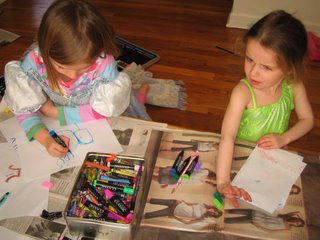 Notice the dress-up clothing. These girls are drawing and writing as part of their pretend play.
Notice the dress-up clothing. These girls are drawing and writing as part of their pretend play.One of the five year olds seemed reluctant to write at first when we all sat down for a writing time at the table. She answered my questions confidently, but referred to her writing only in terms of letter formation and did not seem very secure in her ability to write the alphabet. As the other children started writing and drawing and answering my questions, she observed and thought for a while, and then suddenly her demeanor brightened as she piped up, “Oh – I can write too. I’m a good writer, actually, because I can write numbers.” She started to draw and as I asked her about what she was drawing, she began to add details to her picture and tell me more about her family and their house that she was drawing. The more she talked, the more she drew, and the more she drew, the more details she thought of to tell me about and to add onto her picture. Before long, this reluctant writer had drawn several pages of pictures.
Authentic Writing
Subscribe to:
Posts (Atom)
